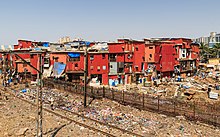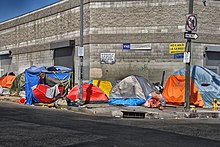User:Hhumberstone/Affordable housing
| This is the sandbox page where you will draft your initial Wikipedia contribution.
If you're starting a new article, you can develop it here until it's ready to go live. If you're working on improvements to an existing article, copy only one section at a time of the article to this sandbox to work on, and be sure to use an edit summary linking to the article you copied from. Do not copy over the entire article. You can find additional instructions here. Remember to save your work regularly using the "Publish page" button. (It just means 'save'; it will still be in the sandbox.) You can add bold formatting to your additions to differentiate them from existing content. |
Affordable Housing and Urbanization
[edit]Lead
[edit]As the world's population continues to increase (expected to reach 9 billion by mid century)[1], more and more people are inhabiting cities for the benefits of industrialization. Those benefits include employment opportunities and better living conditions with access to infrastructure, education, healthcare, and recreation[2]. This process is referred to as urbanization. World Bank reports that by 2050 nearly 7 of 10 people in the world will live in cities[3]. This kind of growth however brings challenges to urban development as cities are tasked with efficiently utilizing resources in accordance with the global demand for affordable housing.
Article body
[edit]The Urban Poor and Homeless
[edit]
Globally, it is estimated that 1.6 billion people live in inadequate housing conditions[4]. The majority of that population live in "urban slums" which are highly populated, impoverished residential areas consisting of densely packed housing that lack proper shelter and basic necessities such as clean water, food, hygiene facilities, and electricity[5]. Slums typically form in developing countries as populations migrate from rural to urban areas searching for employment and better living conditions. But due to the higher prices of urban living and a range of other factors such as economic stagnation, migrators find themselves forced to relocate to such slums[6]. The largest slum in the world is Neza-Chalco-Itza in Mexico, housing almost four million people[7]. According to estimates, by 2030 1 in 4 people on the planet will live in a slum or other informal settlement [8].
Meanwhile, there are approximately 140 million people worldwide who are homeless, usually as a result of being evicted from slums[9]. Since slum residents don't own a title or lease to property, they are often evicted from their home by someone with a claim to the land and left without one[10]. The same principle is applied in the United States as people who are unable to afford their mortgage or rent are evicted and left homeless.
The State of Homelessness in America
[edit]In September 2019, the Council of Economic Advisers from the Executive Office of the President of the United States published the report: The State of Homelessness in America. The report found that "[O]ver half a million people go homeless on a single night in the United States" with approximately 65% or 350,000 people living in homeless shelters and 35% - just under 200,000 people - are unsheltered in the streets (living on sidewalks or in parks, cars, or abandoned buildings)[11]. Almost half (47%) of all unsheltered homeless people are found in the state of California. Rates of sheltered homelessness are highest in Boston, New York City, Washington D.C. with NYC alone containing over one-fifth of all sheltered people in the U.S.[11] In a framework of supply and demand the report analyzes the major factors that causes the variation in homelessness across communities. Considering the four major drivers of homeless populations: (i) the higher price of housing resulting from overregulation of housing markets; (ii) the tolerability of sleeping on the street (outside of shelter or housing); (iii) the supply of homeless shelters; and (iv) the characteristics of individuals in a community that make homelessness more likely[11], the report concludes with federal policies and programs aimed at reducing homelessness.

The first factor contributing to an increase in homelessness is the higher price of housing resulting from the overregulation of housing markets. As stated in President Trump’s Executive Order Establishing a White House Council on Eliminating Regulatory Barriers to Affordable Housing, such regulations include: “overly restrictive zoning and growth management controls; rent controls; cumbersome building and rehabilitation codes; excessive energy and water efficiency mandates; unreasonable maximum-density allowances; historic preservation requirements; overly burdensome wetland or environmental regulations; outdated manufactured-housing regulations and restrictions; undue parking requirements; cumbersome and time-consuming permitting and review procedures; tax policies that discourage investment or reinvestment; overly complex labor requirements; and inordinate impact or developer fees.” These regulations reduce the supply of housing and as a result increase the price of a home. Given the relationship between higher home prices and homelessness, the report simulated the impact of deregulation on housing in individual metropolitan areas. It showed that if 11 metropolitan areas with significantly supply constrained housing were deregulated, homelessness would fall by 54 percent in San Francisco, by 50 percent in Honolulu, by 40 percent in Oxnard and Los Angeles, by 38 percent in San Diego, by 36 percent in Washington, D.C., and by between 19 and 26 percent in Boston, Denver, New York, Seattle and Baltimore.[11]
The second factor the report provides is the tolerability of sleeping on the street (outside of shelter or housing). Studies show that cities with warmer climates have significantly higher rates of unsheltered homelessness compared to cities with cold climates.[11] The homeless are more accepting of unsheltered living in areas with warmer conditions, hence why Los Angeles and San Diego have some of the highest unsheltered rates.
The third factor that explains variation in homelessness is the supply of substitutes to housing through homeless shelters. "Some places, including New York City, the State of Massachusetts, and the District of Columbia – provide a legal “right to shelter” that promises shelter of some minimum level of quality"[11]. This means that regardless of occupancy, the shelter ensures a certain level of quality. "Thus, as long as the minimum shelter quality is set high enough (i.e., higher than equilibrium quality levels reached in other places), we would expect right-to-shelter places to have a larger supply of homeless shelters."[11] Since a larger shelter supply entails a higher shelter quality, people who otherwise wouldn't be homeless are found living in shelters because they provide a better alternative. This results in a decrease in the demand for housing and an increase in homelessness.
The fourth and final cause of homelessness is a higher prevalence of individual-level risk factors. These factors include mental health, substance abuse, incarceration, poverty, and social ties [11]. "According to the 2018 homeless point-in-time count, 111,122 homeless people (20 percent) had a severe mental illness and 86,647 homeless people (16 percent) suffered from chronic substance abuse. Among all adults who used shelter at some point in 2017, 44 percent had a disability." [11] In addition, "people experiencing homelessness generally have low incomes and relatively weaker social ties."[11] While the vast majority of people with these issues are not homeless, there is a strong connection to those who are.
The Federal Government provides funding to communities to support homeless assistance programs. The Department of Housing and Urban Development (HUD) is the largest source of Federal funds, providing $2.6 billion combined via the Continuum of Care (CoC) program and Emergency Solution Grant program alone in 2019.[11] These two programs support competitive funding to communities for homeless outreach, emergency shelter, transitional housing, rapid rehousing, permanent supportive housing and homelessness prevention. The U.S. Department of Veterans Affairs (VA) provides $1.8 billion for programs that serve homeless veterans, in addition to funding from HUD targeted specifically to homeless veterans.[11] Other smaller sources of funding include the U.S. Department of Health and Human Services, the U.S. Department of Education, and the U.S. Department of Labor. State and local governments and private philanthropy provide substantial funding and support for homeless assistance as well.[11]
The Trump Administration implemented a range of policies in conjunction with homeless assistance programs in addressing the four major drivers of homelessness. Most significant was the reformation of the Housing First approach which provides competitive funding to CoC's. While the program maintains a commitment to providing housing with no preconditions to program participants, the 2019 Notice of Funding Availability allowed communities flexibility to impose service participation requirements for participants after they have been stabilized in housing.[11] Such reforms allow homeless assistance programs help vulnerable homeless individuals become self-sufficient through employment and earning an income.
References
[edit]- ^ "The Age of Megacities | National Geographic Society". education.nationalgeographic.org. Retrieved 2022-08-10.
- ^ Miranda (2019-10-31). "The Impact of Urbanization". Flash Parking. Retrieved 2022-08-10.
- ^ "Overview". World Bank. Retrieved 2022-08-10.
- ^ "First-ever United Nations Resolution on Homelessness | DISD". www.un.org. Retrieved 2022-08-11.
- ^ "The Emergence of Urban Slums | Smart Cities Dive". www.smartcitiesdive.com. Retrieved 2022-08-11.
- ^ "The Emergence of Urban Slums | Smart Cities Dive". www.smartcitiesdive.com. Retrieved 2022-08-11.
- ^ "The Emergence of Urban Slums | Smart Cities Dive". www.smartcitiesdive.com. Retrieved 2022-08-11.
- ^ Phillip, Kanika (2017-12-07). "The World's Largest Slums: Dharavi, Kibera, Khayelitsha & Neza". Habitat for Humanity GB. Retrieved 2022-08-12.
- ^ "First-ever United Nations Resolution on Homelessness | DISD". www.un.org. Retrieved 2022-08-12.
- ^ "What is a Slum? Definition of a Global Housing Crisis". Habitat for Humanity GB. Retrieved 2022-08-12.
- ^ a b c d e f g h i j k l m n The Council of Economic Advisers: The State of Homelessness in America. September 2019. Executive Office of the President of the United States.
